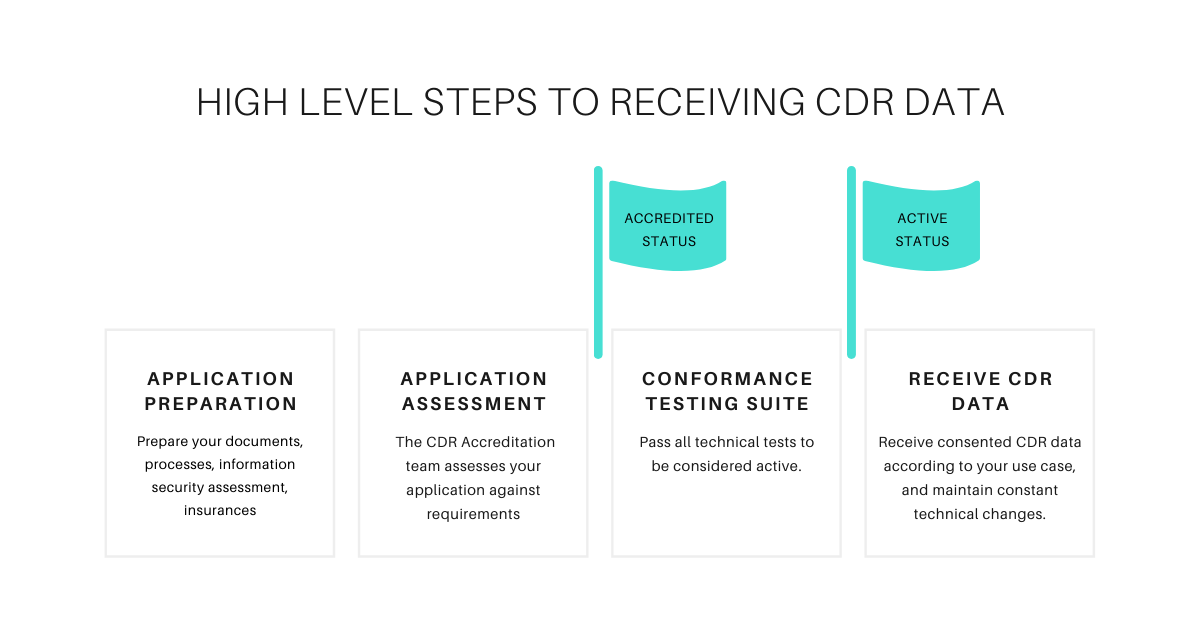
Adatree hears from companies all the time, “I want to be accredited as soon as possible, help me get there.” What we should actually be hearing is, “I want to be active as soon as possible.”
If you’re thinking of how you can leverage the Consumer Data Right for your use cases, understanding the difference between regulatory statuses is key. After all, CDR isn’t a project, it is a program of work.
This post delineates the differences between Active and Accredited statuses, outlining what is actually required to bring a use case to life and receive CDR data.

What Are The Differences Between Accredited and Active Statuses?
Both Accredited and Active Statuses are formal milestones for companies participating in the CDR. Here’s a quick comparison:
|
Accredited Status |
Active Status |
|
|
Connect to Data Holders in production? |
No |
Yes |
|
Receive live data? |
No |
Yes |
|
Official CDR registry status? |
Yes |
Yes |
|
Able to use CDR logo |
Yes |
Yes |
|
Technically Conformant |
No |
Yes |
|
Use Case Status? |
Planned or Built |
Built |
About Accredited Status
Accreditation is a formal status given by the ACCC to companies that meet the accreditation requirements, including:
- Having the required processes and policies in place,
- there are fit and proper checks carried out,
- insurances are in place,
- An information security assurance report has been completed,
- you have some very secure laptops with controls in place, and
- The ACCC has accredited your organisation…
…but you can’t receive consumer data yet.
Being accredited is equivalent to getting a banking licence but not being able to accept deposits. You’re on your way there, but you have a long way to go.
Check out Adatree’s ADR Accelerator to fast track your Accreditation journey.
About Active Status
If Accreditation is the first phase, Active is the second and final stage. You can only receive CDR data when you are Active.
Active is a different status in the CDR Register and essentially puts you into production. Each use case you have is registered with the ACCC.
It is largely technical, meaning you meet the initial and ongoing consumer data standards, as defined by the Data Standards Body. You also have to have your complaint processes, internal and external policies live.
How Do You Achieve Active Status?
Being Active means that you have met all of the technical conformance tests, referred to as CTS. This means that you have met all of the standards in the consent lifecycle and have a technical solution in place that meets all requirements to go active with live CDR data.
Passing CTS is required for being Active, but the CTS doesn’t test every single one of the technical standards. Passing CTS doesn’t mean that you’re conformant. Every Active ADR is required to meet the ongoing changes to technical standards and accreditation status is contingent on it.
What do I need to do to pass the CTS?
CTS makes sure you are conformant with CDR standards before you are allowed to take part in the ecosystem. There are hundreds of pages of standards to meet, but there are four key tests for ADRs:
- Dynamic Client Registration: asserts that the ADR can successfully obtain an access token, a list of register Data Holders and a Software Statement Assertion from ACCC Register; additionally, it also tests that it is able to register its software product with CTS provided Data Holder.
- Consent Test: Verifies the request for once-off data sharing and data sharing with duration.
- Consent Withdraw Test: Tests for initiating withdrawal of consent to data sharing, notifying a data holder and receiving withdrawal of consent; additionally, it tests for initiating withdrawal of consent arrangement and receiving withdrawal of consent arrangement from a data holder.
- API Test: the last step is to assert that the Get Accounts and Get Transactions For Account banking API works as expected.
When to perform CTS?
CTS is not a testing tool used during your software development lifecycle; you should only start CTS once your software is production grade and fully conforms to the CDR standards.
How long does CTS last?
CTS can be a very quick process (around an hour) if your provider configuration is correct and your software is conformant with the CDR standards. Otherwise, the process can take many weeks or months if issues are found with your solution.
Fast Tracking Being Active
Reaching Active is way more complicated than being Accredited, but it doesn’t have to be.
Any organisation can be accredited as an ADR and leverage Adatree’s active status and conformant SaaS Data Recipient Platform to access CDR data. This means that you are the ADR that is customer facing and accredited in your own right, while Adatree is an outsourced service provider (OSP) with an ADR status to leverage our technical solution instead of building your own.
This goes back to the question of Build versus Buy for CDR. You can read more on that here, but the TL;DR says it makes more economic, timing and efficiency sense to license than to build.
In Summary
While being Accredited is an important status on your journey to realise your use case, Active status is the real hurdle you need to overcome to bring your data-driven customer propositions to life.

